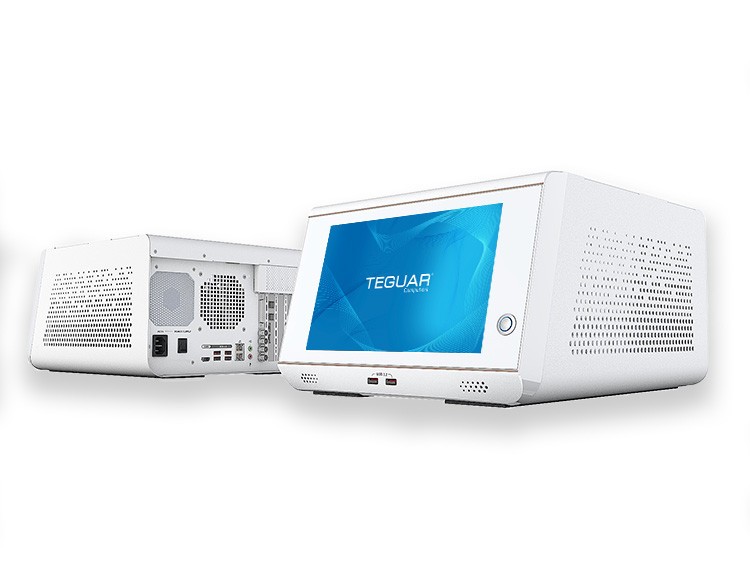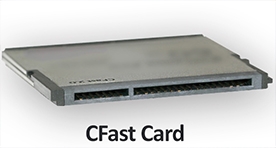Industrial Computer Memory Types Explained
SSD (Solid State Drive)
Solid State Drives (SSD) have been and still continue to replace Hard Disk Drives (HDD) in the industrial and consumer space. Prices have decreased dramatically over the years that make it an attractive option for both consumer and industrial grade computers. SSD data transfer speeds have already surpassed HDD’s and the fact that it can withstand higher shock and vibration specs by not having any mechanical parts makes it a more popular option. SSD’s are still more expensive for larger capacities over 1TB and higher, but you can expect that to come down over time with newer silicon manufacturing technology.
SSD’s are comprised of memory IC’s, and a controller on a printed circuit board (PCB) that requires custom and proprietary firmware which each manufacturer owns. One brand might have an advantage on read/write speeds temporarily while others maintain high write speed bandwidths consistently, which would be beneficial for those recording HD video. Below is a photo showing various types of SSD drives.
 Photo from left to right: 2.5” SATA SSD, Half Slim SATA SSD, mSATA SSD, m.2 2282, m.2 2242
Photo from left to right: 2.5” SATA SSD, Half Slim SATA SSD, mSATA SSD, m.2 2282, m.2 2242
SSD Pros:
- Various sizes: Half Slim, 1.8”, 2.5”, mSATA,M.2 (various sizes), NVME, Dongle, BGA SSD
- Various interfaces: SATA, PCIe, IDE
- Various Speeds & Technology: TLC/MLC/SLC, Power backup
SSD Cons:
- Larger form factors
- Higher Cost
- Higher power consumption
CFAST
CFAST has replaced Compact Flash (CF) cards which were the first compact form of solid state technology that was readily available to the market in 1995. CFAST has upgraded from the slower IDE Compact Flash interface to SATA III while keeping a similar form factor. CFAST slots can be embedded inside a computer or in push/pull spring loaded sockets for easy access.
CFAST cards are able to replace the functionality of both HDD/SSD’s and other forms of flash drives for various reasons. CFAST is still a small form factor storage device that has the ability to withstand shock, vibration, extreme temperatures, while maintaining high endurance. This has been a popular configuration for users that need to remove and transfer confidential data from a computer or as a bootable drive. Companies also prefer the ease of accessing CFAST slots if an OS needs to be updated on the fly.
CFast Pros:
- Easily Removable for storage of Media and operating systems
- Various Speeds & Technology: MLC/iSLC/SLC
- Low Power consumption
- Small form factor with high storage capacity
CFast Cons:
- Not a popular interface
- Not a lot of manufacturers so price is not as competitive
- Limited to SATA interface speeds
eMMC (embedded Multi Media Card)
Embedded Multi Media Cards (eMMC) have been the most popular for embedded solutions such as tablets and mobile phones as it is the smallest form factor and lowest cost solution for storage. The latest standard is set by JEDEC and is currently e.MMC v5.1. eMMC which regulates everything from mechanical dimension of the chip to performance.
Adoption of eMMC has increased as performance and cost effectiveness had improved. The demand for thinner & cost effective industrial solutions have now led to eMMC chips on embedded motherboards with wide temperature range operation. The downfall to eMMC design vs SSD is that the controller is structured differently and all built into a tiny integrated circuit.
Below you will see how the eMMC is directly mounted onto a motherboard as they come in a BGA (Ball Grid Array) package that has to be installed during SMT (Surface Mount Technology) production of the motherboard. This means no easy plug ins or upgrades by yourself, however with the proper equipment it is possible to desolder and resolder BGA packages back to a PCB. New versions of EMMC called EMCP now incorporate the EMMC IC with LPDDR RAM to make it more efficient.
 eMMC Pros:
eMMC Pros:
- Small form factor which reduces footprint & weight
- Lower Cost
- Low Power consumption
- Consistent performance improvements
eMMC Cons:
- Slower speeds
- On board memory so cannot upgrade storage size easily
- Limited storage capacity per IC
Previous Article
Teguar’s New 22” Mobile Medical Computer with 7th Gen Intel Core i3/i5/i7 CPU













